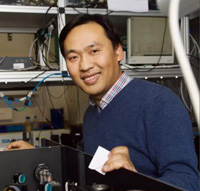题目:Carrier Generation and Transport in Novel Low-Dimensional Organic Semiconductors
报告人:Hai Wang (王海) (Utrecht University)
时间:7月21日(周一)9:30-11:00
地点:李薰楼468房间
摘要:
The conversion of light into electrical currents is a fundamental process underlying the operation of various optoelectronic devices, including photovoltaics and photodetectors. Understanding the underlying photophysics, e.g., the generation and transport of charge carriers in photoactive materials following photoexcitation, is crucial for improving the energy conversion efficiency of these devices. Layered two-dimensional (2D) materials are emerging building blocks for next-generation electronics and optoelectronics. Since the discovery of graphene, the family of 2D materials has expanded significantly. The recent emergence of conductive semiconducting organic layers (e.g., graphene nanostructures and organic frameworks) has further extended the 2D materials library and introduced new functionalities for applications.
In this talk, I will first provide an overview of ultrafast THz spectroscopy and demonstrate its utility in characterizing the electrical transport properties of charge carriers in low-dimensional materials in a contact-free manner¹. I will then discuss recent work on understanding charge generation and transport mechanisms in novel organic semiconductors, including: (1) Giant exciton effects and free carrier generation mechanisms in graphene nanoribbons²⁻³, (2) Band-like charge transport in covalent organic frameworks⁴⁻⁵, and the impact of dimensionality (1D vs. 2D) on charge transport properties⁶
References
1. Wenhao Zheng et al., Nat. Phys. 18,544–550 (2022).
2. Alexander Tries et al., Nano Lett. 20,2993–3002 (2020).
3. Guanzhao Wen et al., Hot Exciton Dissociation in Graphene Nanoribbons, submitted.
4. Shuai Fu et al., J. Am. Chem. Soc. 144,7489–7496 (2022).
5. Mingchao Wang et al., Nat. Mater. 22,880–887 (2023).
6. Shuai Fu et al., Nat. Commun. 16,2219 (2025).

Hai Wang studied materials science at Zhejiang University and obtained his degree in 2009. Between 2009 and 2011,he finished a joint master program in nanoscience at University of Leuven (2009-2010) in Belgium and Delft University of Technology in the Netherlands (2010-2011),supported by the Erasmus Mundus fellowship. From 2012,Hai started his PhD at Max Planck Institute for Polymer Research (MPI-P) in Mainz with the support of a fellowship from MAINZ (graduate school of excellence, materials science in Mainz). In his PhD, Hai worked with Prof. dr. Mischa Bonn to investigate ultrafast charge transfer processes at oxide interfaces, and graduated with the highest honor in 2016. After spending 1 year in the group of Mathias Kläui at University of Mainz as a postdoc, Hai started his independent research group “Nano- optoelectronic materials” in the Molecular Spectroscopy department at MPI-P in 2017, and further moved to Utrecht University as a tenured assistant professor in 2023. Employing time-resolved, ultrafast spectroscopies (THz spectroscopy, transient absorption etc.), the central theme of Hai’s current research lies in understanding fundamental charge carrier dynamics and low-energy excitations in solid-state low-dimensional materials and interfaces, relevant for energy and optoelectronic applications.



